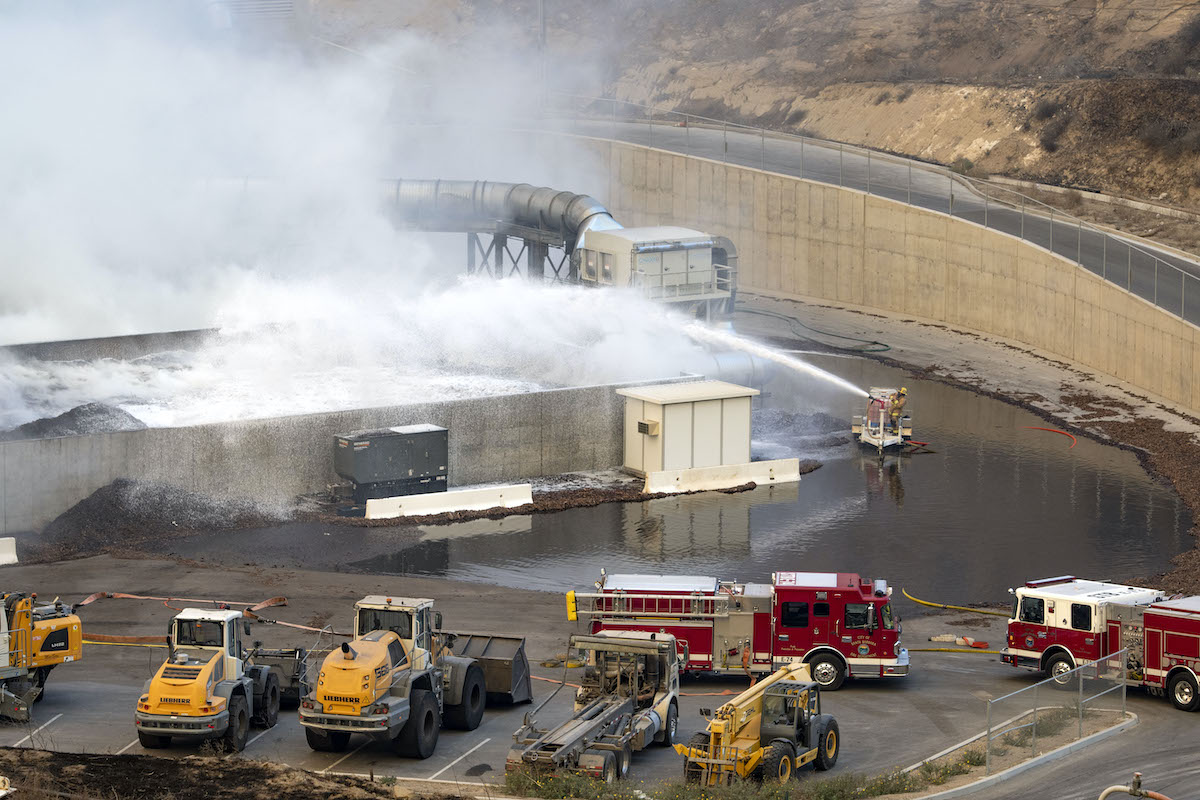Alisal Fire Update: Freeway 101 Opened and Train Service Restored
County Landfill Thrashed; Trash to Be Hauled to Ventura

The California Highway Patrol has reopened Highway 101 in the Alisal Fire area around 6 p.m. this evening, but the evacuation zones remain in effect. A map of the evacuation warning and evacuation order areas can be found at ReadySBC.org.
The press release from the Sheriff’s Office states that traffic into the evacuation zones is restricted and there will be roadblocks in these areas to prevent access. The Sheriff’s Office has increased patrol in these areas to ensure security of the residences and buildings as well as to keep the area clear of traffic that would impede firefighting efforts.
Train service was also restored today at 4 p.m. along the fire-scarred railroad tracks for the first time since the Alisal Fire broke out this Monday, allowing trains to travel north and south. The first train reportedly went through at 4:15 p.m.
According to press officers with the fire’s incident command, the big concern has been the large trees along the side of the freeway and the extent to which their root systems were compromised by the fire. The prospect of large trees falling onto passing motorists is enough to give the actuarial experts at Caltrans fits, as does the prospect of large boulders careening down fire-scarred hillsides onto the freeway. Lastly, much of the wood in many of the Caltrans guardrails went up in smoke during the Alisal Fire; based on secondhand reports, Caltrans people have been working morning, noon, and night trying to get the freeway safe enough to resume passage, The detour required up and down Highway 154 — steep, curving, and overwhelmed with frustrated drivers — has been far from ideal.
All this suggests at least a momentary glimmer of hope regarding the galloping spread of the Alisal Fire, which jumped from 100 acres upon first notification this Monday to more than 16,000 acres as of this morning. Wind conditions along the fire’s eastern front — that’s the side closest to Goleta — calmed down considerably today, though the flank closest to Gaviota still saw frisky wind conditions.
Even so, the skies were buzzing with fixed-wing aircraft and air tankers bombarding the flames below with flame retardant, and helicopters were dropping payloads of water. Press officers with the incident command reported success today establishing a line at the top of the ridge along West Camino Cielo; the hope is to box in the fire and keep it from rampaging down the back slopes of the mountains on its way to Santa Ynez Valley. In addition, great focus was placed on thwarting the fire from bulging out further to the west.
The most obvious and immediate bad news was the fate of the county’s landfill at Tajiguas Canyon. According to Scott McGolpin, the county’s Public Works czar, damage sustained by the landfill’s new high-tech $150 million recycling operations — only just installed and not yet fully operational — will effectively shut down the dump probably for months — not weeks — to come. According to McGolpin, Santa Barbara’s trash will need to be hauled to the Toland landfill in Ventura County now at a cost of $500,000 a month.
Making matters worse, the county will lose $2 million a month in tipping fee revenues it now gets from garbage deposited in the Tajiguas landfill. That’s only the tip of the iceberg, if 16,000-acre infernos can be likened to icebergs. The county will have to spend at least $10 million replacing the biofilter for the county’s new Materials Recovery facility (MRF), at which our trash is placed on conveyor belts and the recyclable materials plucked off and sent — and sold — elsewhere. The biofilter — imagine a 12-inch-thick concrete structure that takes up about half an acre of space packed with old trees and tree branches. This organic material acts as a filter for the massive quantities of particulate matter that would otherwise choke the air inside the MRF. Without that biofilter, the MRF can’t operate. And without the MRF, the landfill can’t operate either. Otherwise, McGolpin explained, all the recyclables will wind up occupying the landfill’s limited licensed space. And right now, he added, there’s no power available anymore to run the MRF because it was powered by methane extracted from the heaping mounds of organic waste stored at the site. The plastic pipes that carried this methane gas extruded from this waste — enough to power 1,000 homes — all melted during the fire, and given the post-pandemic supply shortages of just about everything, McGolpin was not confident that new pipes could be obtained in anything resembling a hurry.
The good news, McGolpin noted, was that the fire could have inflicted far worse damage. The MRF itself, he said, could have gone up in smoke. He praised his staff and firefighting crews for saving as much of the new $150 million facility — the product of more than 15 years of planning, persuading, and political arm-twisting — as was saved.
On another note, there’s been apprehensive behind-the-scenes talk that heavy rains might be in Santa Barbara’s future about a week from now; the term “atmospheric river” has been bandied about. This in turn has raised the specter of another debris flow. But according to the National Weather Service, there’s absolutely no indication rains of that magnitude are on Santa Barbara’s short-term horizon. Such rains, we’ve been told, might be predicted for northern California, ravaged by multiple fires so vast that they are now categorized as fire complexes.
Find all our updates on the Alisal Fire here.
Support the Santa Barbara Independent through a long-term or a single contribution.



